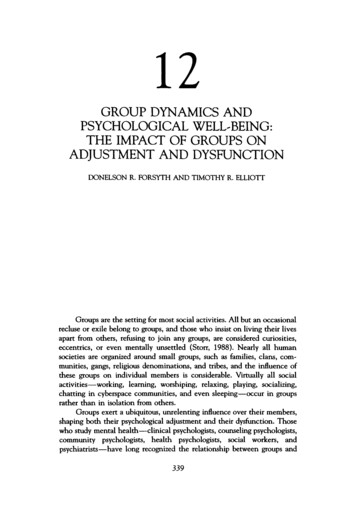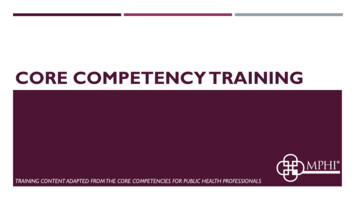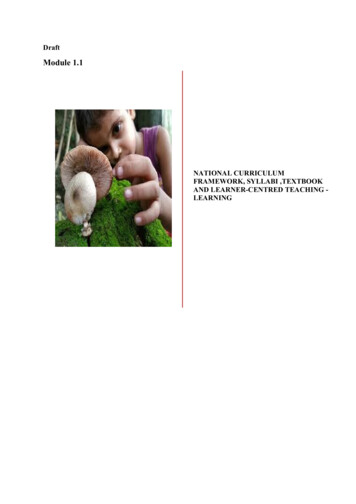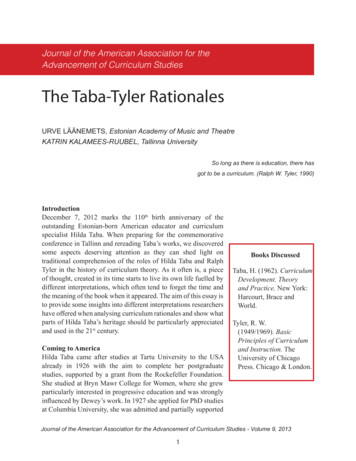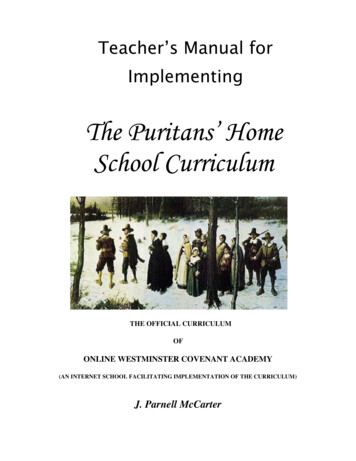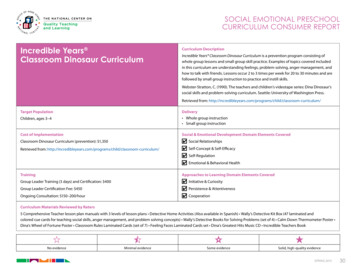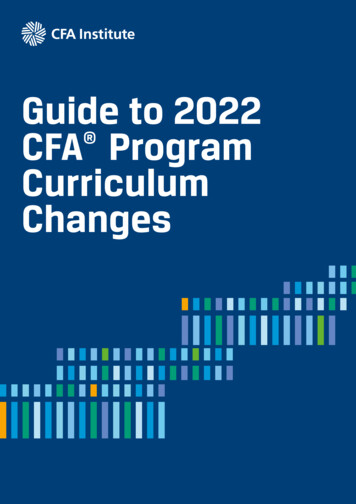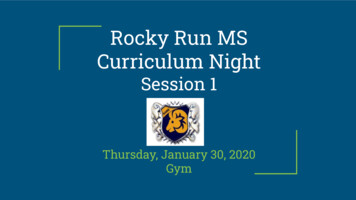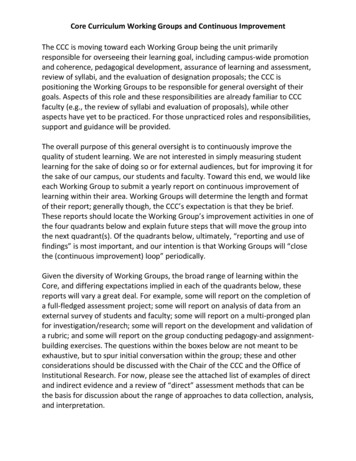
Transcription
Core Curriculum Working Groups and Continuous ImprovementThe CCC is moving toward each Working Group being the unit primarilyresponsible for overseeing their learning goal, including campus‐wide promotionand coherence, pedagogical development, assurance of learning and assessment,review of syllabi, and the evaluation of designation proposals; the CCC ispositioning the Working Groups to be responsible for general oversight of theirgoals. Aspects of this role and these responsibilities are already familiar to CCCfaculty (e.g., the review of syllabi and evaluation of proposals), while otheraspects have yet to be practiced. For those unpracticed roles and responsibilities,support and guidance will be provided.The overall purpose of this general oversight is to continuously improve thequality of student learning. We are not interested in simply measuring studentlearning for the sake of doing so or for external audiences, but for improving it forthe sake of our campus, our students and faculty. Toward this end, we would likeeach Working Group to submit a yearly report on continuous improvement oflearning within their area. Working Groups will determine the length and formatof their report; generally though, the CCC’s expectation is that they be brief.These reports should locate the Working Group’s improvement activities in one ofthe four quadrants below and explain future steps that will move the group intothe next quadrant(s). Of the quadrants below, ultimately, “reporting and use offindings” is most important, and our intention is that Working Groups will “closethe (continuous improvement) loop” periodically.Given the diversity of Working Groups, the broad range of learning within theCore, and differing expectations implied in each of the quadrants below, thesereports will vary a great deal. For example, some will report on the completion ofa full‐fledged assessment project; some will report on analysis of data from anexternal survey of students and faculty; some will report on a multi‐pronged planfor investigation/research; some will report on the development and validation ofa rubric; and some will report on the group conducting pedagogy‐and assignment‐building exercises. The questions within the boxes below are not meant to beexhaustive, but to spur initial conversation within the group; these and otherconsiderations should be discussed with the Chair of the CCC and the Office ofInstitutional Research. For now, please see the attached list of examples of directand indirect evidence and a review of “direct” assessment methods that can bethe basis for discussion about the range of approaches to data collection, analysis,and interpretation.
Core Curriculum Working Groups and Continuous Improvement Reporting and Use of FindingsWhat are your findings?How will you use these findings forimprovement?What form will reporting take and whowill receive the report?How will these findings and usesinform the next cycle?Data Analysis and Interpretation Will the approach to analysis bequantitative, qualitative, or a mix ofthe two? Who will be involved in the analysisand when will it take place? How will you address issues ofreliability, validity, and credibility?Planning and Design Which outcome(s) will you investigateand why? What is the learning‐oriented researchquestion? Can your design be simplified while stillholding the potential for useful,meaningful results?Data Collection What type(s) of evidence will becollected? How will you balance data collectionwith practical considerations (e.g.,feasibility, time, effort, and cost)? If data collection involves others, howwill you ensure participation?
Evidence of Student Learning (based on work by Peggy Maki)Products that provide direct evidence of learning: Student work samples from tests and exams developed within the program Research papers and/or reports Homework assignments Laboratory experiments/reports Observations of students (e.g., observing adherence to laboratory safety protocols) Online postings, such as discussion threads, wikis, blogs, podcasts, and YouTube videos Capstone projects/culminating assignments Collections of student work/portfolios, electronic or paper based. Performances, creations, exhibits Presentations. Poster sessions. Panel discussions Senior seminars and/or projects. Thesis evaluation. Juried review of student projects Internships (internally and/or externally reviewed) Team-based or collaborative projects Performance on national licensure examinations Nationally-standardized tests (e.g., ETS’s Major Field Achievement Tests, GRE Subject Tests) Pre- and post-tests Placement/competence tests (e.g., SMC math placement test) Learning logs/diaries Certificate or licensure exams Clicker-based responses Case study, critical incident, event analysis Class-based activity in a virtual reality, such as Second Life Oral examinationProducts that provide indirect evidence of learning: Course grades Student course evaluations Students’ written self-reflections/self-assessment of their learning Alumni, employer, student surveys Focus groups Exit interviews with graduates Curriculum, syllabus, and transcript analysis Transfer and retention studies Job placement/graduate school acceptance statisticsProducts that do not provide evidence of learning: Enrollment trends Patterns of how courses are selected or elected by students Faculty to student ratios Percentage of students who graduate within a certain period of time Diversity of the student body Alumni honors, awards, achievements Size of the budget, endowment, etc. Faculty publications (unless students are involved)
Nationally-standardized tests (e.g., ETS's Major Field Achievement Tests, GRE Subject Tests) Pre- and post-tests Placement/competence tests (e.g., SMC math placement test) Learning logs/diaries Certificate or licensure exams Clicker-based responses Case study, critical incident, event analysis


